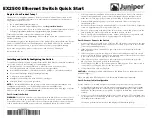
Modular Ethernet Switch User’s Guide
20
Switch Management Concepts
IP Addresses and SNMP Community Names
Each Switch has its own IP Address, which is used for communication with an SNMP network manager or
other TCP/IP application (for example BOOTP, TFTP, etc.). You must provide the switch with an IP Address
to meet the specification of your networking address scheme.
In addition, you can also set an IP Address for a gateway router. This becomes necessary when the network
management station is located on a different IP network as the Switch, making it necessary for management
packets to go through a router to reach the network manager, and vice-versa.
For security, you can set in the Switch a list of IP Addresses of the network managers that you allow to
manage the Switch. You can also change the default Community Name in the Switch and set access rights of
these Community Names.
Traps
Traps are messages that alert you of events that occur on the Switch. The events can be as serious as a reboot
(someone accidentally turned
OFF
the Switch), or less serious like a port status change. The Switch generates
traps and sends them to the network manager (trap managers). The following lists the types of events that
can take place on the Switch.
◊
System resets
◊
Errors
◊
Status changes
◊
Topology changes
◊
Operation
You can also specify which network managers may receive traps from the Switch by setting a list of IP
Addresses of the authorized network managers.
Trap managers are special users of the network who are given certain rights and access in overseeing the
maintenance of the network. Trap managers will receive traps sent from the Switch; they must immediately
take certain actions to avoid future failure or breakdown of the network.
The following are trap types a trap manager will receive:
♦
Cold Start
This trap signifies that the Switch has been powered up and initialized such that software
settings are reconfigured and hardware systems are rebooted. A cold start is different from a factory
reset.
♦
Warm Start
This trap signifies that the Switch has been rebooted, however the Power-On Self-Test
(POST) is skipped.
♦
Authentication Failure
This trap signifies that someone has tried to logon to the switch using an
invalid SNMP community name. The switch automatically stores the source IP address of the
unauthorized user.
♦
New Root
This trap indicates that the Switch has become the new root of the Spanning Tree, the trap
is sent by a bridge soon after its election as the new root. This implies that upon expiration of the
Topology Change Timer the new root trap is sent out immediately after the Switch’s selection as a new
root.
♦
Topology Change
A Topology Change trap is sent by the Switch when any of its configured ports
transitions from the Learning state to the Forwarding state, or from the Forwarding state to the
Blocking state. The trap is not sent if a new root trap is sent for the same transition.
















































